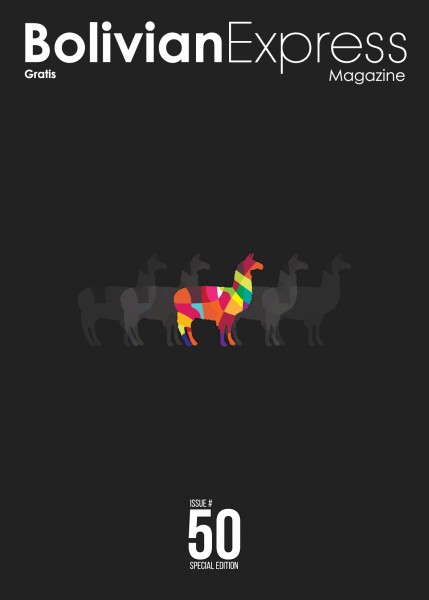
Five years ago Bolivian Express was born between a japanese restaurant and a lift on Avenida 20 de Octubre in La Paz. During the clunky journey from the ground floor to the 17th storey, two young gentlemen and a Swiss-Indian chica lamented the absence of an English-language publication in the country; two notable predecessors—the Bolivian Times and Llama Express—were sadly no longer in circulation. And so the name of the magazine was born as a portmanteau of sorts, an homage to the magazine’s forebearers.
We were determined to find a viable way of printing a quality free publication, given the erratic nature of local advertising revenues and shortage of local English-language journalists. A further (Irish) founder was enlisted and six university friends were boarded on a plane, kidnapped to serve as editorial guinea pigs. It became clear to the founding team that an ideal way of sustaining the project as a whole would be to combine it with a journalism training programme.
What started off as a magazine for tourists quickly turned into something else. After the first 10 issues, we had already covered all the well-trodden festivities and attractions the country is probably best known for. The continuous challenge has been to find new stories from which everyone, including the local audience, can learn something new. Indeed, over half of our readers are native Spanish speakers, so we are as committed to writing for them as we are for the uninitiated in Bolivia. This work has brought us close to people we would perhaps never have had an excuse to get to know: from former presidents, ministers and local sporting heroes, to Michael Jackson impersonators, prisoners serving life sentences and private investigators.
Since our unconventional beginnings, the project has involved over 120 people from 20+ countries worldwide who have come to volunteer as part of the effort.Today, the Bolivian Express team of volunteers live and sleep in a shared house as they explore the country, its stories and cultures with the help of a local team. By looking beyond the salt-flats and ancient ruins, their mission is to bring new eyes to this infinite land. If they leave as cultural ambassadors, rather than just tourists, the project has achieved one of its aims. And, of course, by flicking through these pages you, the reader, are closing the circle and helping to complete this project’s mission.
Over the years we have also worked with a large number of people across the world: editors scattered across San Francisco, New York and Caracas, a web developer in Berlin, an editor and marketing director somewhere in the Swiss alps, and even a virtual assistant in Bulgaria (hey, Pavlin). As past team members have taken on new challenges, others have appeared and have reshaped the project anew. With this, our 50th issue, we are incredibly proud to say that Bolivian Express has a life of its own; it exists as something greater and wiser than the people who have made it possible so far.
Thank you for being a part of this journey.
ILLUSTRATION: OSCAR ZALLES
It can be said that a large percentage of Bolivians have eaten agachaditos. The word ‘agachadito’ means ‘crouch’, but in reality, it is more than its literal meaning. It means to crouch in the street, eating good, cheap food amongst the fresh air. Señora Hilda has been selling agachaditos since she was a girl: ‘It was my mother’s business, and I learned it in order to sell and to cook for her. It is not easy to get this business, you know—you need to get permission from the mayor.’ The peak time for sales is from 11 am until 2 pm. ‘All the people like what we serve because it is available during the day and the dishes are rich Bolivian dishes: ajicitos, soups, something warm when it is cold, and something quick when you are hungry’, says Señora Hilda.
PHOTO: THELMA FANOLA
Twenty-five kilometers from the city of Potosí, in Tarapaya and across a rocky canyon that arrives at ‘the Devil’s Cave’ (according to locals, a place where the Devil resides) and ‘Soldier’s Rock’ (named for its anthropomorphous shape), is a hill with a huge lagoon on its crest. Called el Ojo del Inca (the Eye of the Inca), this thermal and sulphurous body of water has a legend behind it that says that the Inca Huyna Kapac used to bathe in it in order to alleviate health problems from which he was suffering. It is from this that the name was derived. The lagoon is of volcanic origin and is very popular with visitors, who still believe that it has healing properties.
ILLUSTRATION: FREEPIK.COM
In Bolivia, the origins of unionism lie in the revolution of 1952, a moment in time that was a determining factor consolidating the start of the representation of the working class and the social struggles of the people. Thanks to the fights of May 1, 1886, Bolivians managed to win basic rights such as a maximum eight-hour workday, 15 days of vacation per year, and a monthly minimum wage (which had variations depending on the political and economic model). The first trade union organizations, particularly mining workers dating back decades from 1910 to 1920, began to raise demands against the business owners Patiño, Hoschild and Aramayo.
The socio-historical meaning tells us that May is a time of reflection, representing the demands of workers but also raising awareness of work as a source of life and advancement for society.

 Download
Download





















